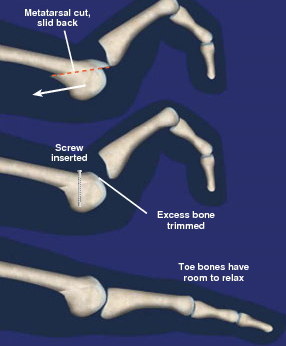 Lesser metatarsal osteotomy (also known as weil osteotomy) is a foot procedure performed to correct toe deformities of the metatarsals or metatarsalgia which is a type of rheumatoid arthritis. This type of osteotomy is often performed in conjunction with bunion surgery.
Lesser metatarsal osteotomy (also known as weil osteotomy) is a foot procedure performed to correct toe deformities of the metatarsals or metatarsalgia which is a type of rheumatoid arthritis. This type of osteotomy is often performed in conjunction with bunion surgery.
The Weil osteotomy has become one of the most commonly performed surgeries on the foot in the world. The most common indications for the Weil osteotomy are painful metatarsalgia originating from an elongated or plantarflexed metatarsal that has failed to respond to conservative care.
Many studies worldwide have proven the utility of the Weil osteotomy (3,4) since a successful execution can eliminate many of the problems that are commonly associated with the procedure.
Metatarsal shortening osteotomies are used to correct toe angulation or dislocation commonly seen in hammertoe or claw toe deformities. When the toe is dislocated, the deformity must be addressed with a metatarsal shortening osteotomy. The second indication is to relieve pressure under a metatarsal head which is commonly associated with a callus and/or pain in the ball of the foot.
Weil Osteotomy Procedure
The procedure starts with an incision around the are where the metatarsal meets the foot. Multiple incisions may be needed if more than one metatarsal needs to be operated on. Then, the surgeon uses a saw to cut the metatarsal bone and perform the osteotomy (when the bone is cut). The two bone ends are repositioned so that the bone becomes shortened.
This shortening creates space to the toe so it can be placed in the correct position relieving the pain under the foot and/or toe clawing. After the appropriate amount of sliding has occurred, the osteotomy is held in position with either pins or metal screws. Then, the skin is closed with stitches.
If you have any additional questions or concerns, contact our South Florida foot doctor at 954-906-9272 and make an appointment today.
Post-operative care
Immediately after the osteotomy surgery, the foot is bandaged and the patient will have to wear a hard-soled shoe carefully placing his/her weight only on the heel when standing up or walking. The patient usually can go home the same day.
In order to avoid swelling, the patient should keep the foot elevated as much as possible. Showers/bathing can be done with either a plastic bag or commercially available cover to keep the dressings dry. If the patient experience excess swelling, it needs to be reported to his foot and ankle surgeon as soon as possible as it can lead to problems with wound healing.
A post-op appointment is usually scheduled one to two weeks after surgery where the bandage is changed and the stitches are removed. The patient is also advised on range-of-motion exercises with the toe. After four to six weeks, weight bearing is usually allowed as tolerated.
If you feel you would benefit from a lesser metatarsal osteotomy procedure don’t hesitate to contact our office today for a consultation with a lead podiatrist in South Florida. Schedule an appointment online today.
References:
1. American Orthopaedic Foot & Ankle Society – http://www.aofas.org/footcaremd/treatments/Pages/Lesser-Metatarsal-Shortening-Osteotomy.aspx
2. Podiatry Today – https://www.podiatrytoday.com/blogged/how-correctly-perform-weil-osteotomy
3. DeHeer P. Are you taking the easy way out with the Weil osteotomy? Podiatry Today DPM Blog. Available at http://www.podiatrytoday.com/blogged/are-you-taking-easy-way-out-weil-osteotomy . Published Sept. 18, 2012. Accessed March 30, 2016.
4. Henry J, Besse JL, Fessy MH. Distal osteotomy of the lateral metatarsals: a series of 72 cases comparing the Weil osteotomy and the DMMO percutaneous osteotomy. Orthop Traumatol Surg Res. 2011; 97(6 Suppl):S57-65.
